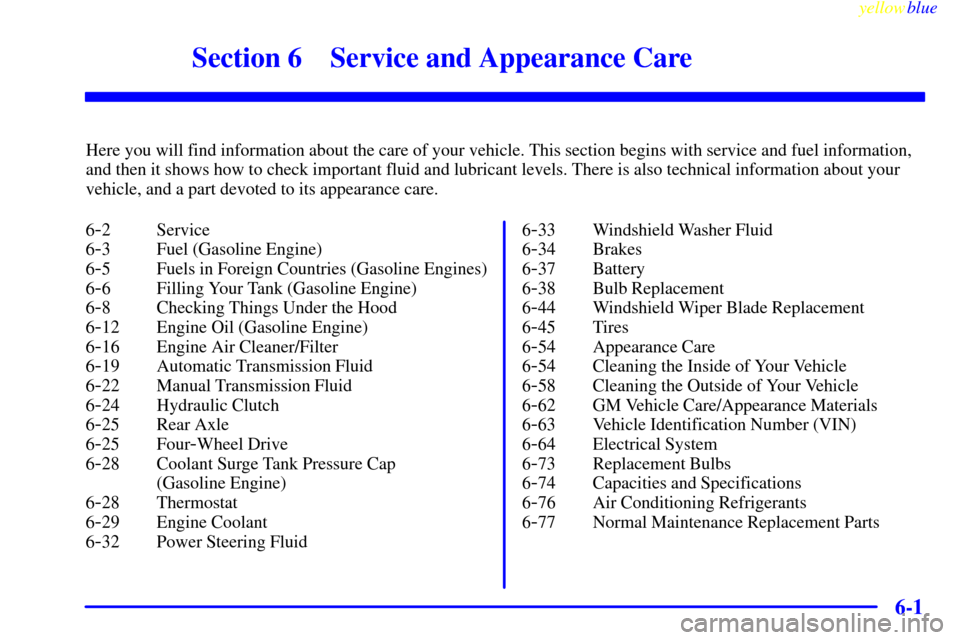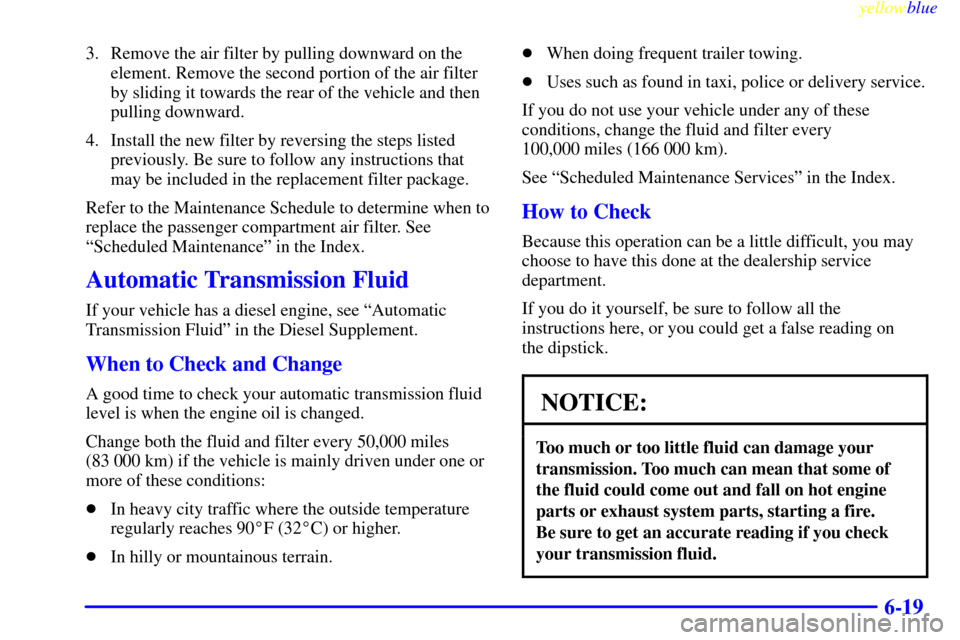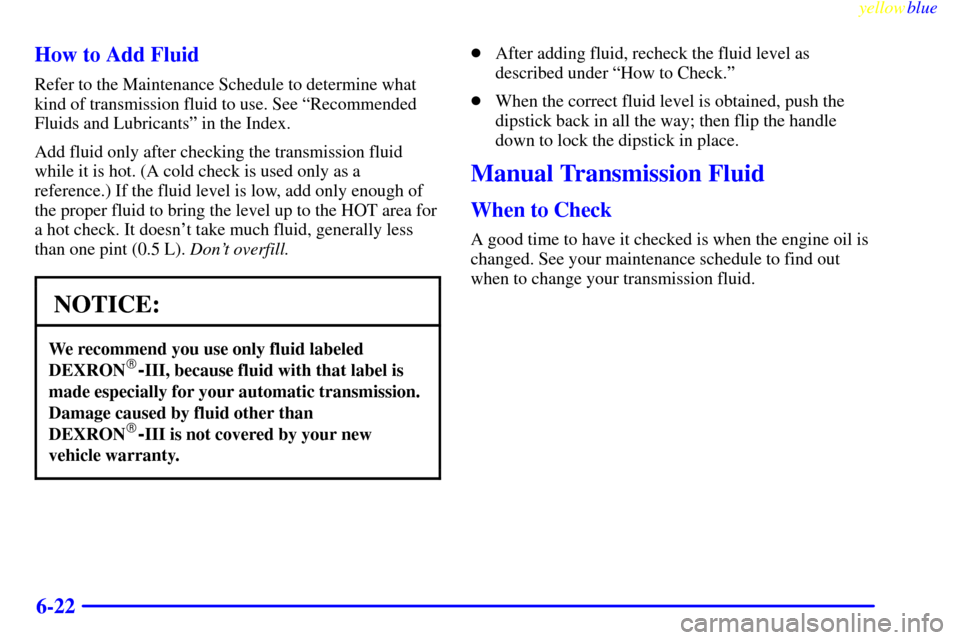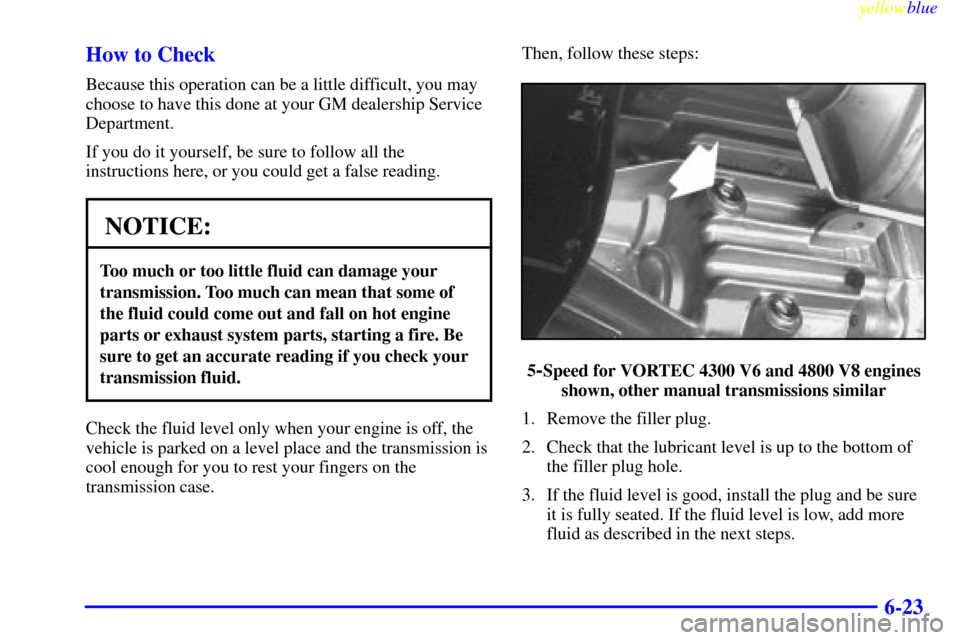Page 299 of 432

6-
yellowblue
6-1
Section 6 Service and Appearance Care
Here you will find information about the care of your vehicle. This section begins with service and fuel information,
and then it shows how to check important fluid and lubricant levels. There is also technical information about your
vehicle, and a part devoted to its appearance care.
6
-2 Service
6
-3 Fuel (Gasoline Engine)
6
-5 Fuels in Foreign Countries (Gasoline Engines)
6
-6 Filling Your Tank (Gasoline Engine)
6
-8 Checking Things Under the Hood
6
-12 Engine Oil (Gasoline Engine)
6
-16 Engine Air Cleaner/Filter
6
-19 Automatic Transmission Fluid
6
-22 Manual Transmission Fluid
6
-24 Hydraulic Clutch
6
-25 Rear Axle
6
-25 Four-Wheel Drive
6
-28 Coolant Surge Tank Pressure Cap
(Gasoline Engine)
6
-28 Thermostat
6
-29 Engine Coolant
6
-32 Power Steering Fluid6
-33 Windshield Washer Fluid
6
-34 Brakes
6
-37 Battery
6
-38 Bulb Replacement
6
-44 Windshield Wiper Blade Replacement
6
-45 Tires
6
-54 Appearance Care
6
-54 Cleaning the Inside of Your Vehicle
6
-58 Cleaning the Outside of Your Vehicle
6
-62 GM Vehicle Care/Appearance Materials
6
-63 Vehicle Identification Number (VIN)
6
-64 Electrical System
6
-73 Replacement Bulbs
6
-74 Capacities and Specifications
6
-76 Air Conditioning Refrigerants
6
-77 Normal Maintenance Replacement Parts
Page 308 of 432
yellowblue
6-10
VORTEC 4300 V6 Engine
When you lift up the hood you'll see:
A. Air Cleaner
B. Coolant Surge Tank
C. Air Filter Restriction Indicator
D. Engine Oil Dipstick
E. Automatic Transmission
Dipstick (If Equipped)F. Fan
G. Engine Oil Fill
H. Power Steering Fluid Reservoir
I. Remote Negative Terminal (GND)
J. Remote Positive Terminal
K. Brake Fluid ReservoirL. Clutch Fluid Reservoir
(If Equipped)
M. Underhood Electrical Center
N. Battery
O. Windshield Washer Fluid
Reservoir
Page 309 of 432
yellowblue
6-11
VORTEC 4800, 5300 and 6000 V8 Engine
VORTEC 5300 V8 engine shown, locations for other engines similar.
A. Air Cleaner
B. Coolant Surge Tank
C. Air Filter Restriction Indicator
D. Engine Oil Dipstick
E. Automatic Transmission
Dipstick (If Equipped)F. Engine Oil Fill
G. Fan
H. Remote Negative Terminal (GND)
I. Power Steering Fluid Reservoir
J. Remote Positive Terminal
K. Brake Fluid ReservoirL. Clutch Fluid Reservoir
(If Equipped)
M. Underhood Electrical Center
N. Battery
O. Windshield Washer Fluid
Reservoir
Page 317 of 432

yellowblue
6-19
3. Remove the air filter by pulling downward on the
element. Remove the second portion of the air filter
by sliding it towards the rear of the vehicle and then
pulling downward.
4. Install the new filter by reversing the steps listed
previously. Be sure to follow any instructions that
may be included in the replacement filter package.
Refer to the Maintenance Schedule to determine when to
replace the passenger compartment air filter. See
ªScheduled Maintenanceº in the Index.
Automatic Transmission Fluid
If your vehicle has a diesel engine, see ªAutomatic
Transmission Fluidº in the Diesel Supplement.
When to Check and Change
A good time to check your automatic transmission fluid
level is when the engine oil is changed.
Change both the fluid and filter every 50,000 miles
(83 000 km) if the vehicle is mainly driven under one or
more of these conditions:
�In heavy city traffic where the outside temperature
regularly reaches 90�F (32�C) or higher.
�In hilly or mountainous terrain.�When doing frequent trailer towing.
�Uses such as found in taxi, police or delivery service.
If you do not use your vehicle under any of these
conditions, change the fluid and filter every
100,000 miles (166 000 km).
See ªScheduled Maintenance Servicesº in the Index.
How to Check
Because this operation can be a little difficult, you may
choose to have this done at the dealership service
department.
If you do it yourself, be sure to follow all the
instructions here, or you could get a false reading on
the dipstick.
NOTICE:
Too much or too little fluid can damage your
transmission. Too much can mean that some of
the fluid could come out and fall on hot engine
parts or exhaust system parts, starting a fire.
Be sure to get an accurate reading if you check
your transmission fluid.
Page 318 of 432

yellowblue
6-20
Wait at least 30 minutes before checking the
transmission fluid level if you have been driving:
�When outside temperatures are above 90�F (32�C).
�At high speed for quite a while.
�In heavy traffic
-- especially in hot weather.
�While pulling a trailer.
To get the right reading, the fluid should be at normal
operating temperature, which is 180�F to 200�F
(82�C to 93�C).
Get the vehicle warmed up by driving about 15 miles
(24 km) when outside temperatures are above 50�F
(10�C). If it's colder than 50�F (10�C), drive the
vehicle in THIRD (3) until the engine temperature gage
moves and then remains steady for 10 minutes. Then
follow the hot check procedures.Checking Transmission Fluid Cold
A cold check is made after the vehicle has been sitting
for eight hours or more with the engine off and is used
only as a reference. Let the engine run at idle for five
minutes if outside temperatures are 50�F (10�C) or
more. If it's colder than 50�F (10�C), you may have to
idle the engine longer. Should the fluid level be low
during a cold check, you must perform a hot check
before adding fluid. This will give you a more accurate
reading of the fluid level.
Checking the Fluid Level
�Park your vehicle on a level place. Keep the
engine running.
�With the parking brake applied, place the shift lever
in PARK (P).
�With your foot on the brake pedal, move the shift
lever through each gear range, pausing for about
three seconds in each range. Then, position the shift
lever in PARK (P).
�Let the engine run at idle for three minutes or more.
Page 319 of 432
yellowblue
6-21
Then, without shutting off the engine, follow these steps:
1. The red transmission dipstick handle is located at the
rear of the engine compartment, on the passenger's
side. Flip the handle up and then pull out the dipstick
and wipe it with a clean rag or paper towel.
2. Push it back in all the way, wait three seconds and
then pull it back out again.
3. Check both sides of the dipstick, and read the lower
level. The fluid level must be in the COLD area for a
cold check or in the HOT area or cross
-hatched area
for a hot check.
4. If the fluid level is in the acceptable range, push the
dipstick back in all the way; then flip the handle
down to lock the dipstick in place.
Page 320 of 432

yellowblue
6-22 How to Add Fluid
Refer to the Maintenance Schedule to determine what
kind of transmission fluid to use. See ªRecommended
Fluids and Lubricantsº in the Index.
Add fluid only after checking the transmission fluid
while it is hot. (A cold check is used only as a
reference.) If the fluid level is low, add only enough of
the proper fluid to bring the level up to the HOT area for
a hot check. It doesn't take much fluid, generally less
than one pint (0.5 L). Don't overfill.
NOTICE:
We recommend you use only fluid labeled
DEXRON�-III, because fluid with that label is
made especially for your automatic transmission.
Damage caused by fluid other than
DEXRON
�-III is not covered by your new
vehicle warranty.
�After adding fluid, recheck the fluid level as
described under ªHow to Check.º
�When the correct fluid level is obtained, push the
dipstick back in all the way; then flip the handle
down to lock the dipstick in place.
Manual Transmission Fluid
When to Check
A good time to have it checked is when the engine oil is
changed. See your maintenance schedule to find out
when to change your transmission fluid.
Page 321 of 432

yellowblue
6-23 How to Check
Because this operation can be a little difficult, you may
choose to have this done at your GM dealership Service
Department.
If you do it yourself, be sure to follow all the
instructions here, or you could get a false reading.
NOTICE:
Too much or too little fluid can damage your
transmission. Too much can mean that some of
the fluid could come out and fall on hot engine
parts or exhaust system parts, starting a fire. Be
sure to get an accurate reading if you check your
transmission fluid.
Check the fluid level only when your engine is off, the
vehicle is parked on a level place and the transmission is
cool enough for you to rest your fingers on the
transmission case.Then, follow these steps:
5-Speed for VORTEC 4300 V6 and 4800 V8 engines
shown, other manual transmissions similar
1. Remove the filler plug.
2. Check that the lubricant level is up to the bottom of
the filler plug hole.
3. If the fluid level is good, install the plug and be sure
it is fully seated. If the fluid level is low, add more
fluid as described in the next steps.